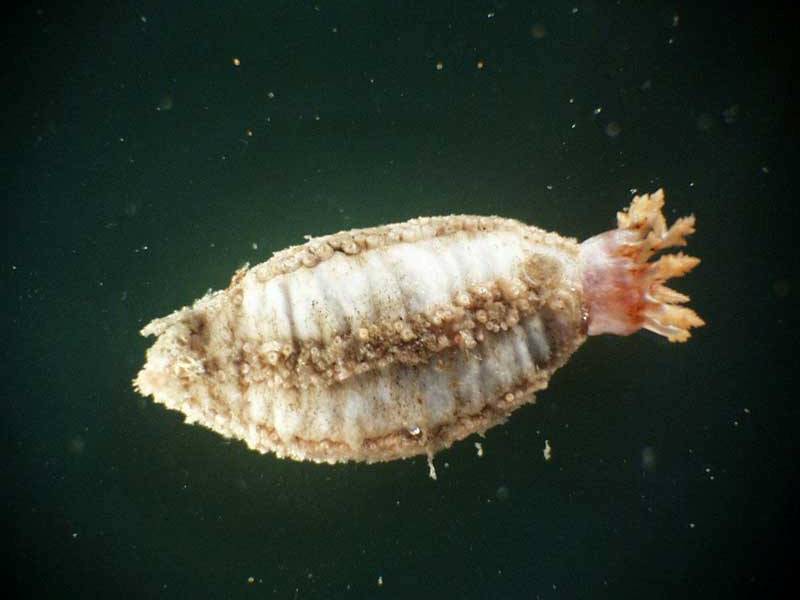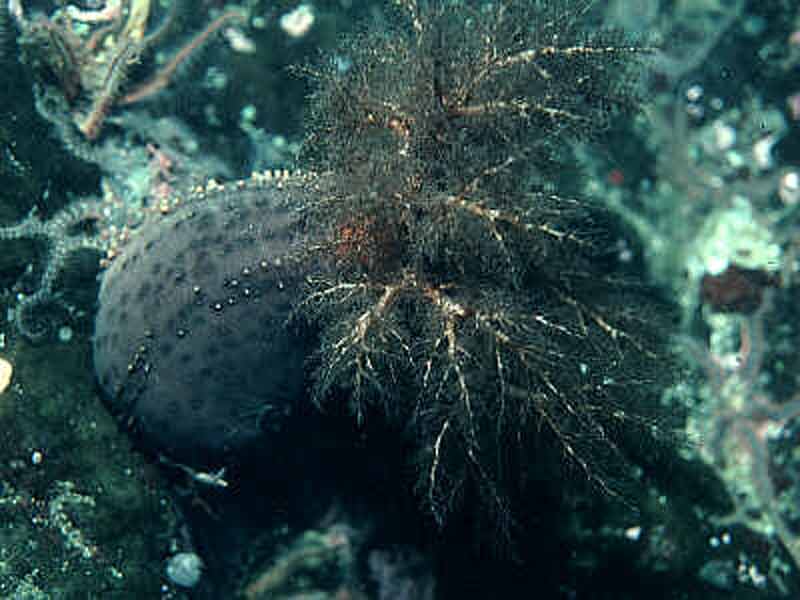A sea cucumber (Cucumaria frondosa)
Distribution data supplied by the Ocean Biodiversity Information System (OBIS). To interrogate UK data visit the NBN Atlas.Map Help
| Researched by | John Bleach | Refereed by | Admin |
| Authority | (Gunnerus, 1767) | ||
| Other common names | - | Synonyms | - |
Summary
Description
Recorded distribution in Britain and Ireland
Found around the Shetlands Islands and the Orkney Islands.Global distribution
-Habitat
Found on the lower shore and shallow sublittoral, to perhaps 200 m, on coarse grounds, often among kelp holdfasts. It can also be found on rocky substrata.Depth range
-Identifying features
- Cylindrical dark brown body up to 50 cm long.
- Tube feet arranged in five, double rows, occasionally occurring between the body radii (in the inter-radii).
- Ten black, bushy tentacles (when extended), usually of equal size.
- Tentacles and mouth region may be colourful.
- Often found among kelp holdfasts.
Additional information
A detailed taxonomic description is provided by McKenzie (1991).Listed by
- none -
Bibliography
Connor, D.W., Dalkin, M.J., Hill, T.O., Holt, R.H.F. & Sanderson, W.G., 1997a. Marine biotope classification for Britain and Ireland. Vol. 2. Sublittoral biotopes. Joint Nature Conservation Committee, Peterborough, JNCC Report no. 230, Version 97.06., Joint Nature Conservation Committee, Peterborough, JNCC Report no. 230, Version 97.06.
Hayward, P., Nelson-Smith, T. & Shields, C. 1996. Collins pocket guide. Sea shore of Britain and northern Europe. London: HarperCollins.
Hayward, P.J. & Ryland, J.S. (ed.) 1995b. Handbook of the marine fauna of North-West Europe. Oxford: Oxford University Press.
Howson, C.M. & Picton, B.E., 1997. The species directory of the marine fauna and flora of the British Isles and surrounding seas. Belfast: Ulster Museum. [Ulster Museum publication, no. 276.]
JNCC (Joint Nature Conservation Committee), 1999. Marine Environment Resource Mapping And Information Database (MERMAID): Marine Nature Conservation Review Survey Database. [on-line] http://www.jncc.gov.uk/mermaid
Lambert, P 1997. Family Cucumariidae UBC Press
McKenzie, J.D., 1991. The taxonomy and natural history of north European dendrochirote holothurians (Echinodermata). Journal of Natural History, 25, 123-171.
Datasets
NBN (National Biodiversity Network) Atlas. Available from: https://www.nbnatlas.org.
OBIS (Ocean Biodiversity Information System), 2025. Global map of species distribution using gridded data. Available from: Ocean Biogeographic Information System. www.iobis.org. Accessed: 2025-08-08
Citation
This review can be cited as:
Last Updated: 17/04/2008




